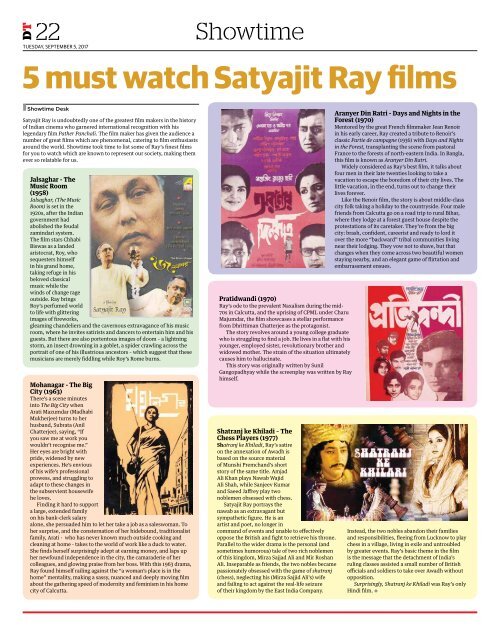e_Paper, Tuesday, September 5, 2017
Create successful ePaper yourself
Turn your PDF publications into a flip-book with our unique Google optimized e-Paper software.
22<br />
TUESDAY, SEPTEMBER 5, <strong>2017</strong><br />
DT<br />
Showtime<br />
5 must watch Satyajit Ray films<br />
• Showtime Desk<br />
Satyajit Ray is undoubtedly one of the greatest film makers in the history<br />
of Indian cinema who garnered international recognition with his<br />
legendary film Pather Panchali. The film maker has given the audience a<br />
number of great films which are phenomenal, catering to film enthusiasts<br />
around the world. Showtime took time to list some of Ray’s finest films<br />
for you to watch which are known to represent our society, making them<br />
ever so relatable for us.<br />
Jalsaghar - The<br />
Music Room<br />
(1958)<br />
Jalsaghar, (The Music<br />
Room) is set in the<br />
1920s, after the Indian<br />
government had<br />
abolished the feudal<br />
zamindari system.<br />
The film stars Chhabi<br />
Biswas as a landed<br />
aristocrat, Roy, who<br />
sequesters himself<br />
in his grand home,<br />
taking refuge in his<br />
beloved classical<br />
music while the<br />
winds of change rage<br />
outside. Ray brings<br />
Roy’s perfumed world<br />
to life with glittering<br />
images of fireworks,<br />
gleaming chandeliers and the cavernous extravagance of his music<br />
room, where he invites satirists and dancers to entertain him and his<br />
guests. But there are also portentous images of doom – a lightning<br />
storm, an insect drowning in a goblet, a spider crawling across the<br />
portrait of one of his illustrious ancestors – which suggest that these<br />
musicians are merely fiddling while Roy’s Rome burns.<br />
Mohanagar - The Big<br />
City (1963)<br />
There’s a scene minutes<br />
into The Big City when<br />
Arati Mazumdar (Madhabi<br />
Mukherjee) turns to her<br />
husband, Subrata (Anil<br />
Chatterjee), saying, “If<br />
you saw me at work you<br />
wouldn’t recognise me.”<br />
Her eyes are bright with<br />
pride, widened by new<br />
experiences. He’s envious<br />
of his wife’s professional<br />
prowess, and struggling to<br />
adapt to these changes in<br />
the subservient housewife<br />
he loves.<br />
Finding it hard to support<br />
a large, extended family<br />
on his bank-clerk salary<br />
alone, she persuaded him to let her take a job as a saleswoman. To<br />
her surprise, and the consternation of her hidebound, traditionalist<br />
family, Arati - who has never known much outside cooking and<br />
cleaning at home - takes to the world of work like a duck to water.<br />
She finds herself surprisingly adept at earning money, and laps up<br />
her newfound independence in the city, the camaraderie of her<br />
colleagues, and glowing praise from her boss. With this 1963 drama,<br />
Ray found himself railing against the “a woman’s place is in the<br />
home” mentality, making a sassy, nuanced and deeply moving film<br />
about the gathering speed of modernity and feminism in his home<br />
city of Calcutta.<br />
Pratidwandi (1970)<br />
Ray’s ode to the prevalent Naxalism during the mid-<br />
70s in Calcutta, and the uprising of CPML under Charu<br />
Majumdar, the film showcases a stellar performance<br />
from Dhrittiman Chatterjee as the protagonist.<br />
The story revolves around a young college graduate<br />
who is struggling to find a job. He lives in a flat with his<br />
younger, employed sister, revolutionary brother and<br />
widowed mother. The strain of the situation ultimately<br />
causes him to hallucinate.<br />
This story was originally written by Sunil<br />
Gangopadhyay while the screenplay was written by Ray<br />
himself.<br />
Shatranj ke Khiladi – The<br />
Chess Players (1977)<br />
Shatranj ke Khiladi, Ray’s satire<br />
on the annexation of Awadh is<br />
based on the source material<br />
of Munshi Premchand’s short<br />
story of the same title. Amjad<br />
Ali Khan plays Nawab Wajid<br />
Ali Shah, while Sanjeev Kumar<br />
and Saeed Jaffrey play two<br />
noblemen obsessed with chess.<br />
Satyajit Ray portrays the<br />
nawab as an extravagant but<br />
sympathetic figure. He is an<br />
artist and poet, no longer in<br />
command of events and unable to effectively<br />
oppose the British and fight to retrieve his throne.<br />
Parallel to the wider drama is the personal (and<br />
sometimes humorous) tale of two rich noblemen<br />
of this kingdom, Mirza Sajjad Ali and Mir Roshan<br />
Ali. Inseparable as friends, the two nobles became<br />
passionately obsessed with the game of shatranj<br />
(chess), neglecting his (Mirza Sajjid Ali’s) wife<br />
and failing to act against the real-life seizure<br />
of their kingdom by the East India Company.<br />
Aranyer Din Ratri - Days and Nights in the<br />
Forest (1970)<br />
Mentored by the great French filmmaker Jean Renoir<br />
in his early career, Ray created a tribute to Renoir’s<br />
classic Partie de campagne (1936) with Days and Nights<br />
in the Forest, transplanting the scene from pastoral<br />
France to the forests of north-eastern India. In Bangla,<br />
this film is known as Aranyer Din Ratri.<br />
Widely considered as Ray’s best film, it talks about<br />
four men in their late twenties looking to take a<br />
vacation to escape the boredom of their city lives. The<br />
little vacation, in the end, turns out to change their<br />
lives forever.<br />
Like the Renoir film, the story is about middle-class<br />
city folk taking a holiday to the countryside. Four male<br />
friends from Calcutta go on a road trip to rural Bihar,<br />
where they lodge at a forest guest house despite the<br />
protestations of its caretaker. They’re from the big<br />
city: brash, confident, careerist and ready to lord it<br />
over the more “backward” tribal communities living<br />
near their lodging. They vow not to shave, but that<br />
changes when they come across two beautiful women<br />
staying nearby, and an elegant game of flirtation and<br />
embarrassment ensues.<br />
Instead, the two nobles abandon their families<br />
and responsibilities, fleeing from Lucknow to play<br />
chess in a village, living in exile and untroubled<br />
by greater events. Ray’s basic theme in the film<br />
is the message that the detachment of India’s<br />
ruling classes assisted a small number of British<br />
officials and soldiers to take over Awadh without<br />
opposition.<br />
Surprisingly, Shatranj ke Khiladi was Ray’s only<br />
Hindi film. •

















